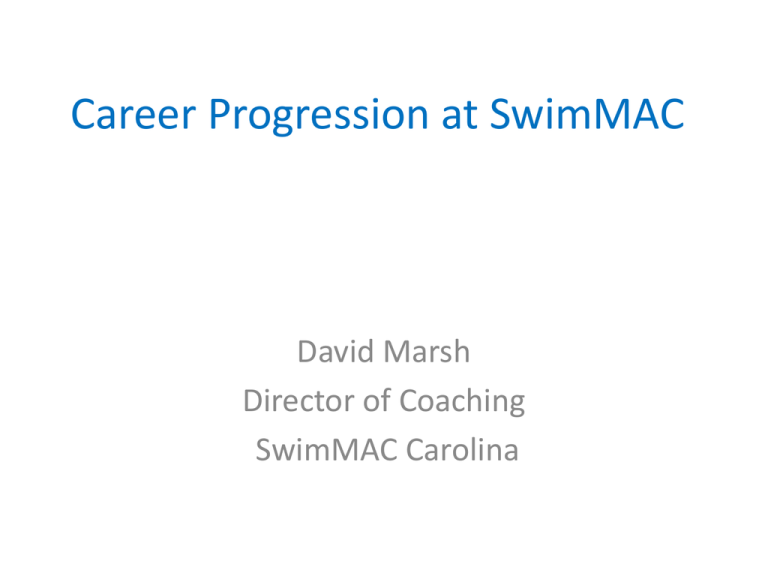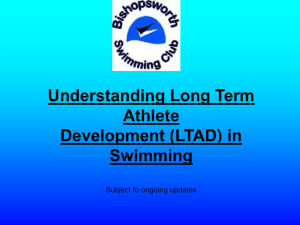Career Progression at SwimMAC
advertisement

Career Progression at SwimMAC David Marsh Director of Coaching SwimMAC Carolina Core Values Govern the operation of the business and its conduct/relationships with all stakeholders (members, staff, vendors, community, etc.) Teamwork Commitment Excellence SwimMAC Carolina Integrity Leadership Development Building the foundation: SwimMAC Carolina Result Strategic Objectives SwimMAC Vision Raise level of community awareness and involvement Build and maintain premiere competitive program; support and develop Olympic Prep Team structure and management Foundation Teamwork Develop and maximize revenue channel with emphasis on fiscal responsibility, stability, and cost control Build and maintain infrastructure, information systems, and facilities Develop a positive member experience that encourages participation Communications Commitment Core Values Integrity Development Leadership Excellence SwimMAC’s Stakeholders How S-P-I-C-E are we? Society: The communities we serve, USA Swimming, NC Swimming, government agencies, the media. Partners: Suppliers, strategic alliances, including materials suppliers, services providers and professional firms. Investors: Parents, businesses, USOC and donors. Customers: Athletes, parents, schools, other swim teams. Employees: Part- and full-time employees, coaches, administrators, their families, and professional associations. Source: “Firms of Endearment” The Big Priorities • Career- Year- Season- Adaptation phase- Meets (Bigmid-season- skill meets)- Practice- Camps- Breaks • Character Development (moral conduct, toughness) • Technique (DPS vs. Tempo, Bodylines, Legs) • Training (“Practice”) Base skills- Aerobic- Details • Versatility (IM, 400-500 focus, multi-event) • Excellence intentions, College considerations, experiential opportunities • Fun, relationships, A Sampling of the Curriculum MARLIN DIVISION NOVA The NOVA group is designed to introduce youngsters ages 6 – 9 to competitive swimming. The focus is almost entirely on teaching fundamentals, developing balance, basic motor skills and coordination in the water. The number one goal is to teach young children to love the water and love the sport. Practice Schedule Ideally four legal strokes, must have three strokes that are legal. Be able to swim 25 yards of all four strokes or three strokes should be really proficient 6-10, deal age range on Nova 7-9 3 practices per week, 1 hour, 3 hours per week, 50 minutes water time, 10 minutes dryland Recommended Attendance 2 practices per week Practice Structure 1)10 minutes dryland/games 2)40 minutes of swim (skills and kicking) 3)5-10 minutes of games or relays in water 80% Instruction, 10% Training 10% relays, Games Teach and continue to improve the basic swimming fundamentals: Body position Stack and lock streamline Properly kick all four strokes Properly swim all 4 strokes Starts and Turns Breathing Patterns for Free and Fly introduced: Fly-every other, Free-every 3 ( for training) Introduce the concept of body dolphin swimming. One they are taught a specific skill they should always perform it correctly Entrance Criteria Practice Guidelines Group Test Sets Competition SwimMAC and Competitive Swimming Education Developmental swim meets that cater to the beginning swimmer. Meets are mostly within the metropolitan area, Possibly including meets in and . 1. 2. 3. 4. Team Cheers SwimMAC Heroes Basic definition of a goal Determine weekly practice goal. Exit Criteria 1)Streamline off every wall with a stack and lock. Be able to push off , back, side, stomach. 2)Has knowledge and can execute at least three Core drills pertaining to each stroke 3)Is comfortable doing short and long axis turns. 4)Has four legal strokes maintaining proper body position 5)Has a legal 100 IM 6)Has knowledge of basic pace clock skills meaning swimmers can go 5 or 10 seconds apart and can go on basic intervals such as :30. :40 or 1:00. 7)Can complete 8 x 50 Free kick under 1:15 on 1:45 interval 8)Has basic practice habits (per practice document) 9)Understands the rules of competitive swimming 10)Legal starts and finishes. 11)Can dive off of a starting block 12)Knows how to do a legal relay start 13)Understands and can display good sportsmanship 14)Age Recommendation: at least 8 years of age preferably 9 Gold Practice Guidelines For swimmers 12 & Under moving to Gold: 1)Attendance-75%, understanding that a Gold swimmer may still be participating in other sports 2)”BB” 11-12 swimmer or close (can make within the season) 3)Can train on slowest intervals listed for Gold 4)Successfully swim a set 1200-1500 yards in length holding proper streamlines, stroke technique, and breathing patterns and be able to get set appropriate rest. (10) 11-12 (13) Gold 5 x 1:45 in the water, 1:30 in water and two 30-40 minute drylands depending upon time of year 4-5 practices, 9 practices every two weeks Yardage is low intensity to moderate intensity and technique oriented, interval training is introduced, and kicking is emphasized representing 1/3 of the weekly yardage. The amount of yardage and intervals is secondary to technique and following directions. Stress good workout habits. 45% Instruction, 55% Training 1)Trains in all 4 strokes. Gold level must be able to swim a 100 in all four strokes 2)Reads pace clock , and can read times on repeats 3)Can hold varying breathing patterns (3-5-7) 4)Is able to do 4 x 25 under water streamline with fins without a breath (interval is quite liberal) 5)Holds body line off the wall in all 4 strokes 6)Holds breath one stroke out of the turn both on Free and Fly. 7)Swims all 4 strokes with a snorkel 8)Race strategies are introduced and practiced Sets should not exceed 2400 yards in duration Kick Set Minimum: Gold-6 x 100 Free kick @ 1:55, 6 x 50 Fly kick on 1:10, Be able to kick all 4 strokes on an interval Note: Kick sets should typically stroke specific not choice. Swim Set Minimum: Gold-8 x 100 Free @1:20- 1:35, 8 x 100 IM @ 1:30-1:45 1:45, 200IM and 200 Free should be staple events to train Group Test Sets Event Focus Competition SwimMAC & Competitive Swimming Education 200, 500 Free, 200 IM NC Swimming Age Group Champs / AG Sectionals 200 IM, 200 & 500 Free Practices are geared toward success in these events Entrance Criteria Practice Schedule Recommended Attendance Practice Structure Exit Criteria . 1)Swimmer becomes eligible 2)Attend meets “BB” through Age Group Sectionals 3)There is an emphasis on season ending meets 4)Swimmers visit with coach pre and post race. At this level swimmers should be able to tell the coach how they will approach the race. 1)Know about your team, history, tradition, local heroes 2)Develop sports heroes 3)Know Team Cheers 4)Read Splash Magazine 5)Use the web to expand knowledge and interest in swimming( website, USA Swimming website, NC Swimming website, Flowswimming) 6)Goals-start to understand the importance of the process of goal setting, not just focusing on outcomes 7)Athletes have one on one goal meetings with Coach 8)Swimmer begins to think about sport outside of practice which influences decision making The swimmers age, competitive level, practice performance, and commitment will determine where the athlete is placed. See Entrance criteria for White, and Blue. Blue Group Entrance Criteria Practice Schedule Recommended Attendance Practice Structure Practice Guidelines Throughout the Shark Division, the proficiency of each of these skills should increase in competency and performance Within the Division, Swimmers will likely come from the or Gold groups. Swimmers are: Legal in all strokes 100% of the time. Have achieved two 13-14 “AA ”times Achieved a 13-14 A time in 200 IM and 500 free. Has the ability to swim 10 X 100 free @ 1:20 Has the ability to swim 10 X 200 IM @ 2:50 Has the ability to kick 10 x 100 Free kick @ 1:40 Willing to compete in one meet / month, representing at all 14 and un Championship meets (LSC and Sectionals)and have a focus meet at the end of the short course and long course season. (12) 13 – 14 (15 developing boy) Six practices / week. 2 hrs water time each practice, 3 45 min. dryland sessions 12 out of 14 practices (2weeks),---85% Swimmers should not miss just to miss. 17/21 (3 weeks) --- 80% 30 % Instruction, 70 % Training --- early season more instruction 1) Refining stroke technique and drills for all strokes. Legal in all strokes 100% of the time 2)Streamline head past the flags off all walls 3)Bilateral breathe in free and fly every two 4)Six beat kick in Freestyle 5)Proper finishes in every stroke a. Freestyle-No breath inside the flags and touch the wall under water with fingertips at full extension b. Backstroke-Touch the wall underwater with the fingertips at full extension on the side c. Breaststroke-Touch the wall under water with the fingertips at full extension with the head in-line with the body d. Butterfly-No breath inside the flags and touch the wall under water with the fingertips at full extension with the head in line with the body. 6)Breathing control into and out of the walls a. Freestyle-No breath the last two strokes into the turn and the first two strokes out of the turn.???? b. Butterfly-No breath the last stroke into the wall and the first stroke off the wall 7)Proper body position and posture 8)Comfortable using snorkel 9)Understand the basics of long axis and short axis turns and IM transition turns a. Long Axis Turn-Rotate in a tight ball with the legs at a 90 degree angle, flip legs directly over the head, slap the calves on the water, feet shoulder width apart, arms stay close to the body and get into a streamline before the feet hit the wall and push off the wall on the back, then turn to the side and pull with the arm closest to the bottom of the pool to rotate into breakout. Continuing to refine the skill of submerging. b. Short Axis Turns-Drive knees to chest very fast after touching the wall, stay in a tight ball just like doing a backward somersault, elbow your brother, and phone your mother, keep head still, place feet on the wall shoulder width apart with the feet turned to the side, and push off the wall on side and quickly turn to your stomach. c. Introduces the back to breast crossover turn to be used in practice until confident to use in meets 10)Understands the basics of all starts a. Dive Start-Use the track start, have proper spacing of the feet, have the proper bend in the legs so the hips are at the proper height to establish the proper line in the water, make sure the hands grip the block with the fingers underneath the arms straight, lean back a little to create tension in the arms, pull up with the hands to get the body moving forward and push with the legs and establish a great streamline and make the whole body enter into one hole in the water. These sequential shall be accomplished in a split second. First push the hands away. Second push hips up. Lastly push with the feet. b. Back Start-Feet shoulder width apart and under water, knees underneath the armpits, legs at 90 degree angle, pull in with the arms while head stays in line with spine, and let everything flow right over the water into a great streamline and one path into the water. c. Relay start-Appropriate step up and relay starts are refined. 11)Understands the basics of all drills 12)Has basic pace clock skills (knows when to leave on any cycle and how to get times), knows number of repeats done and understands average pace they hold on a set. 13)Has own marked practice equipment 14) Learns concept of DPS and stroke count in all strokes. 15)Develops understanding of heart rate and relationship when training. 16)Becoming more efficient with the underwater body dolphin and understanding the rate of kicks (20 per 8 seconds) the 6th stroke, under water swimming 17)Understanding what stroke rate is and tempo needed for racing. Max aerobic set 3600 yards or 60 minutes Senior 1 Practice Schedule Attendance Expectation Swimmers will likely come from Senior 2 and Blue groups. Swimmers are legal in all strokes 100% of the time. Has achieved at least 3 summer long course sectional time standards. Has the ability to swim 5 x 200 free on 2:20- short course (aerobic component that has flexibility to indicate appropriate conditioning). Has the ability to kick 10 x 100 dolphin kick on 1:40- short course. (aerobic component that has flexibility to indicate appropriate conditioning) Has the ability to swim 5 x 200 IM on 4:00- short course, being within: 30 of best time and holding an appropriate SPL standard (approximately at/under 10 spl for short axis and at/under 14 spl for long axis). Able to compete in all meets assigned by the coaching staff. 15 and over (14 year old girls). Up to 22 hours per week during normal training periods. 100 %.( if athlete has dropped below 90% a meeting will be necessary between coach, athlete and parent to discuss commitment level.) Practice Structure Practice Guidelines-These components are what the coaches will stress and the athletes are expected to embrace in order for each swimmer to swim as fast as possible. 1) 2) 3) 4) 5) Entrance Criteria Refining stroke technique and drills for all strokes. Legal in all strokes 100% of the time. Always push off on back and then streamline head past the flags off all walls. Bilateral breathe in free and fly every two when appropriate. Always six beat kick in Freestyle Proper finishes in every stroke a. Freestyle-holding breath inside the flags, touch the wall under water with fingertips at full extension on your side. b. Backstroke-Touch the wall underwater with the fingertips at full extension. c. Breaststroke-Touch the wall under water with the fingertips at full extension with the head in-line with the body with both hands. d. Butterfly-holding breath inside the flags and touch the wall under water with the fingertips at full extension with the head in line with the body. 6) Breathing control into and out of the walls a. Freestyle-Hold breath last stroke into the turn and the first cycle out of the turn. b. Butterfly-Hold breath last stroke into any wall and the first stroke off any wall. 7) Proper body position and posture in all skills. 8) Comfortable using a snorkel. 9) Performs appropriate long axis and short axis turns and IM transition turns a. Long Axis Turn-Rotate in a tight ball with the legs at a 90 degree angle, flip legs directly over the head, slap the calves on the water, feet shoulder width apart, arms stay close to the body and get into a streamline before the feet hit the wall and push off the wall on the back, then turn to the side and pull with the arm closest to the bottom of the pool to rotate into breakout. Continuing to refine the skill of submerging. b. Short Axis Turns-Drive knees to chest very fast after touching the wall, stay in a tight ball just like doing a backward somersault, elbow your brother, and phone your mother, keep head still with eyes on wall, place feet on the wall shoulder width apart with the feet turned to the side, and push off the wall on side and quickly turn to your stomach. c. Performs the back to breast crossover turn to be used in practice and meets. 10) Performs appropriate start technique a. Dive Start-Use the track start, have proper spacing of the feet, have the proper bend in the legs so the hips are at the proper height to establish the proper line in the water, make sure the hands grip the block with the fingers and thumbs underneath the arms straight, lean back a little to create tension in the arms, pull up with the hands to get the body moving forward and push with the legs and establish a great streamline and make the whole body enter into one hole in the water. These sequences shall be accomplished in a split second. First push the hands away. Second push hips up. Lastly push with the feet. b. Back Start-Feet shoulder width apart, knees underneath the armpits, legs at 90 degree angle, pull in with the arms while head stays in line with spine, and then push with hands, throw the arms around the body and finally push with legs as body uncoils over the water. c. Relay start-Appropriate step up and relay starts are refined. 11) Understands the basics of all drills. 12) Responsible for pace clock skills. 13) Has own marked practice equipment. 14) Embraces the concept of DPS, stroke count and stroke rate. 15) Has an understanding of heart rate and its relationship to training. 16) Efficiently performs the underwater body dolphin. Questions? • www.SwimMACcarolina.org • dmarsh@swimmaccarolina.org • www.speedousa.com In honor of: Richard Quick Jimi Flowers









